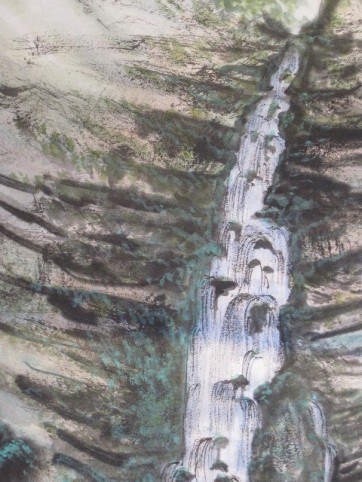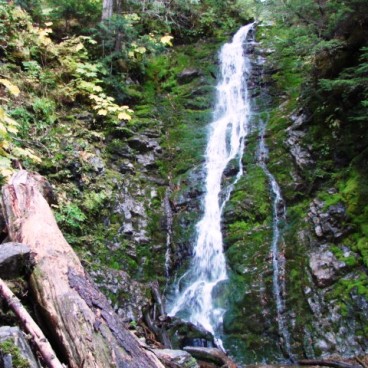My first few afternoons working on waterfalls was no different than had I gone clambering around the slippery rocks of a real waterfall. There were moments where I thought I had a grasp of the brush work, then I would slop on too much water, stroke water spray in unrealistic directions, or discover I’d not varied the tonal values enough and there was no going back.
Painting a waterfall is deceptively complex.
I went back to the guy with the YouTube videos and watched all five in his series of three-minute takes on creating a large waterfall composition. He used only two brushes, a large one with bristles that could be splayed and a smaller detail brush.
He inked in his rocks first, leaving white space for the water. The closer larger rocky surfaces became darker than those farther away. He inserted protruding rocks in the path of the water—varied in shape and always just where they seemed to belong! He stroked in the branches of a tree and dotted in foliage (my Biff brush would do that effectively I noted.) He added more moss to the large foreground rock surface. Pale greenish-grey washes went on the rocks, darker where the rocks were cooler and in shadow, lighter where the light would shine on them.
Ah, if only my brush could dance that way!
While searching for solutions (indulging in procrastination perhaps?) I tripped over an absolutely delightful short (22 minutes) animated film posted on Youtube titled Feelings of mountains and water.
The imagery, the music, the painting—I’m not sure which aspect was the most engrossing.
Fully inspired, back to the falls
With the animation and music filling my mind I turned back to my art table. Surely I too could wield a Chinese brush in the minimalist ways of rocks and water.
In planning to continue with the waterfalls (ultimately aiming to capture the spirits of my two favored ones, Rainbow Falls and Treebeard in the Ancient Forest near McBride) I sought direction on adding color. I found some very concise and helpful guidance in yet another book in my CBP library. This was a book dedicated to the Lingnan School of painting, by artist Lo Ching-Yuan.

His direction for painting a waterfall composition has five steps, which I’ve simplified here:
- Outline rocks either side of intended falls and define a few within the path of the water. In his words: broad arrangement of whole picture.
- Paint flowing water in pale ink; strokes should be smooth and agile. Apply texture strokes to the rocks and add small trees.
- Apply wash of ochre ink to shining spots of rocks and dark blue to darker parts. (This brings forward the parts hit by light and puts others into shadow away from you.)
- Use thin dark blue mixed with mineral green to color the darker parts of the falling water, so that it is more conspicuous. (I think he means comes forward or stands out.) Apply mineral green to the parts of rocks that protrude. Rocks within or next to the falling water stay wet and support moss; hence they should appear brighter green.
- Examine the whole composition and touch up where needed. Add moss or weeds. Apply chop and write annotation.
I set out for my next art group afternoon fully geared up to paint waterfalls! I aimed to try a colored composition in the manner of Lo Ching-Yuan. I had rough sketched my two real inspirations (Rainbow and Treebeard Falls) with two 10 by 14 frames in mind. From my files and library I pulled out two more attractive waterfall compositions, one with a bridge in the far distance and the other with a lot of tumbling water spreading widely into the foreground.
That’s when things went sideways. After a few hours I had naught but messy sheets of paper in front of me. I had to take a step back and consider what was happening.
Reflection on the slippery rocks
- I was expecting too much. Perhaps I should scale back the size and scope of my goals. (Paint ONE waterfall composition?)
- The rock lines in my first stab at Rainbow Falls were all too similar and much like the dreaded “railroad tracks” of BAD tree branch arrangements. (Forget what was real and adjust for a pleasing composition. Use your artistic licence.)
- Rainbow Falls captured by a camera appeared wide; hence they were best represented in a “landscape” or horizontal mode, not the vertical arrangement I was forcing them into. (Rethink the composition.)
- My color choices were resulting in a starkly orange-and-blue painting. (Too much thinking about that ochre wash on the light rock faces and blue wash on the shadowed parts! Rethink the color application.) Watercolorists know they’re in trouble when the palette shows a muddy mix; mine held sharp contrasts.
- My washes applied to rocks were bleeding into wet “blooms”. (Yikes! Don’t forget to blot and don’t try to color so many surfaces with one brushload.)
- Waterfalls are hard, said TOB. Don’t worry, this is like riding a bicycle; two weeks away and you may be a bit rusty, but it will all come back, said Lotus. Their kind words only reinforced what I knew: it was time to review plan A.
Plan B for the waterfalls
I decided to give Treebeard Falls a go. They were naturally more suited to the vertical comp I had in mind. The falling water made a simpler path to portray. The surroundings could be altered by foreground foliage. And the messy sheets of my attempts to capture Rainbow Falls were too much in my head.
(At this stage I serendipitously viewed a FB posting on Billie Jean King describing how she “deleted” from her computer/brain incorrect responses to approaching tennis balls. So I cleared my head of prior attempts at painting falls, and conjured up the afternoon I spent at Treebeard Falls in the Ancient Forest.
I followed Lo Ching-Yuan’s steps as best I could. Here’s the result, with the inspirational photograph following it.


I then worked up a composition based on the distant bridge with wider tumbling falls moving into the foreground.

In the end I was displeased with both results on many levels: messy water marks, too dark ink on the rocks, nondescript foliage. Rocks and waterfalls would simply require more practice, more study, and perhaps less hurry. Sometimes you just can’t get water to run downhill that easily. And maybe I’ll have to work on Billie Jean King’s mind control method as well. (Delete, delete, delete.)
